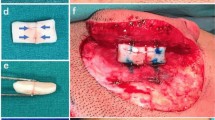Abstract
Purpose
This case study improves an operative method of ear reconstruction for microtia patients by using a four-layer rib cartilage framework to increase transverse height of the reconstructive ear to a natural level in one operative stage.
Materials and Methods
The procedures of ear reconstruction were conducted from February 2014 to May 2016. The ear framework used in the procedures was fabricated from autologous rib cartilage into a four-layer spliced sculpture. Totally 23 patients with unilateral microtia were willing to be enrolled in this study.
Results
After the operation, 23 patients achieved 2.3–2.8 cm transverse height of reconstructed ears, which was basically the same as the normal side. Both patients and their families felt satisfied with the results. Follow-up was performed at 6–16 months after the procedures. Only one case showed significantly lowered transverse height of the reconstructed ear, compared to the normal one. It was due to the sleeping position of the patient (10-year-old boy), which put the reconstructed ear under pressure and reduced the transverse height of the ear.
Conclusions
The method of four-layer sculpted autologous rib cartilage ear reconstruction has good clinical effect. It can provide a reconstructed ear that reaches normal transverse height and avoids a third operation to increase the transverse height by rib cartilage transplantation.
Level of Evidence IV
This journal requires that authors assign a level of evidence to each article. For a full description of these Evidence-Based Medicine ratings, please refer to the Table of Contents or the online Instructions to Authors www.springer.com/00266.






























Similar content being viewed by others
References
Park GC, Wiseman JB, Clark WD (2000) Correction of congenital microtia using stereolithography for surgical planning. Plast Reconstr Surg 105:1444–1450
Yotsuyanagi T, Yokoi K, Nihei Y (1999) Management of the hairline using a local flap in total reconstruction for microtia. Plast Reconstr Surg 104:41–48
Tanzer RC (1977) Reconstructive plastic surgery, 2nd edn. WB Saunders, Philadelphia
Tanzer RC (1975) The constricted (cup and lop) ear. Plast Reconstr Surg 55:406–415
Brent B (1999) Technical advances in ear reconstruction with autogenous rib cartilage grafts: personal experience with 1200 cases. Plast Reconstr Surg 104:319–322
Nagata S (1994) Modification of the stages in total reconstruction of the auricle: part I. Grafting the three-dimensional costal cartilage framework for lobule-type microtia. Plast Reconstr Surg 93:221–230
Nagata S (1994) Modification of the stages in total reconstruction of the auricle: part II. Grafting the three-dimensional costal cartilage framework for concha-type microtia. Plast Reconstr Surg 93:231–242
Nagata S (1994) Modification of the stages in total reconstruction of the auricle: part III. Grafting the three-dimensional costal cartilage framework for small concha-type microtia. Plast Reconstr Surg 93:243–253
Mccarthy JB (1990) Plastic surgery. W. B. Saunders Company, Philadelphia, pp 2097–2099
Wei W (ed) (1999) Plastic surgery. Zhejiang Science and Technology Press, Hangzhou, p 1079
Zhuang Hongxing, Jiang Haiyue, Pan Bo et al (2006) Congenital microtia skin soft tissue expander method of ear reconstruction. Chin J Plast Surg 22(4):286–289
Firmin F (1998) “Ear reconstruction in cases of typical microtia. Personal experience based on 352 microtic ear corrections. Scand J Plast Reconstr Surg Hand Surg 32(1):35–47
Alexander G, Rajacic N, Ibrahim MK et al (2002) The combined posterior temporoparietaland galeal fascial flap: a new flap in the elevation of the constructed auricle (second stage of microtia correction). Br J Plast Surg 55(7):582–584
Sivayoham E, Woolford T (2012) Current opinion on auricular reconstruction. Curr Opin Otolaryngol Head Neck Surg 20:287–290
Nagata S, Brent BD (1994) Modification of the stages in total reconstruction of the auricle: part IV. Ear elevation for the constructed auricle. Plast Reconstr Surg 93:254–268
Zhang GL, Zhang JM, Liang WQ et al (2012) Implant double tissue expanders superposingly in mastoid region for total ear reconstruction without skin grafts. Int J Pediatr Otorhinolaryngol 10:1515–1519
Bo Pan, Hai-yue Jiang, Hong-xing Zhuang et al (2009) Application of quantitative Uissue expansion in ear reconstruction. Chin J Plast Surg 25(4):254–257
Storck K, Bas M, Gurr A et al (2013) Complications in 312 cases of nasal and auricular reconstruction via autologous rib cartilage. Laryngorhinootologie 92:808–814
Acknowledgements
The authors thank the patients for their participation. They would also like to thank PhD. Huihui Liu for assistance with editing the English language of this paper.
Funding
This study was funded by Health and Family Planning Commission of Wuhan Municipality (Grant No. WX14A10).
Author information
Authors and Affiliations
Corresponding author
Rights and permissions
About this article
Cite this article
Wan, R., Pang, X. & Ren, J. Using Four-Layer Sculpted Rib Cartilage Framework to Increase Transverse Height of the Reconstructive Ear in One Operative Stage for Microtia Patients. Aesth Plast Surg 42, 167–175 (2018). https://doi.org/10.1007/s00266-017-1014-9
Received:
Accepted:
Published:
Issue Date:
DOI: https://doi.org/10.1007/s00266-017-1014-9




